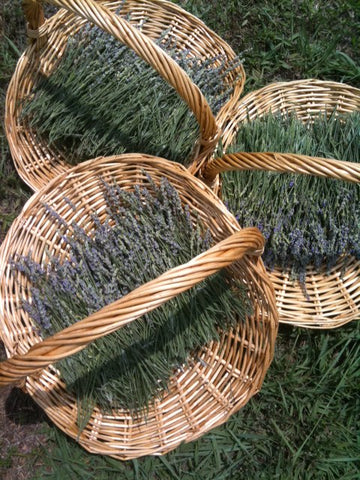
The plant itself was originally cultivated in the mediterranean and spread throughout Europe by the Romans. Romans and Carthaginians were famous for their baths, made more lovely and therapeutic by the addition of lavender to the water. Hence, the derivation of the name lavender, from "lavare," to wash. Some men washed their heads with lavender to ward off diseases or weakness arising from a cold. Others believed lavender would invoke ecstasy and constancy in love.
Egyptians, Phoenicians and Arabians used lavender as a perfume. They also used it for burial. They mummified their dead in lavender-dipped shrouds. Historians suggest that Cleopatra's (69-30 BCE) secret weapon was lavender. She dabbed its essential oil on her wrists, using its scent to seduce both Julius Caesar and Mark Antony. Some sources say she died from the prick of an asp, a poisonous snake that had been hiding in one of her lavender bushes. But we prefer the opposing view, which lets lavender off the hook, saying she plotted her own suicide by the asp's bite.
The Greeks gave it a different name, "nardus," from the city of Naarda in Syria. Nard, or spikenard, was considered of high value and thought to cure everything from insomnia and aching backs to insanity. Pliny (23-79AD) notes that blossoms of nardus sold for 100 Roman denarii ( a month's wages for a day laborer) per pound. This equaled the cost of 10 pounds of bread or 10 liters of wine. The Bible mentions ointment made from this plant. Mark 14:3, "While He [Jesus] was in Bethany, reclining at the table in the home of a man known as Simon the Leper, a woman came with an alabaster jar of very expensive perfume made of pure nard. She broke the jar and poured the perfume on his head." It is possible that this Mary was Lazarus' sister, clearly using this plant to honor the Lord she loved so dearly.

Lavender is credited with the beginnings of the perfume industry in France. Sixteenth century glove makers' wares were not only pleasant to smell, they helped ward off cholera.
Shakespeare (1564-1616) definitely knew of lavender, though it did not make the list of Bacon's favorites. The Bard's mention of the plant goes like this:
"Here's flowers for you;
Hot lavender, mints, savoury, marjoram
The marigold, that goes to bed withe sun
And with him rises weeping."
~The Winter's Tale, 4.3
Queen Elizabeth I (1533-1603) favored culinary lavender, especially a conserve made with the flowers. She also consumed great quantities of lavender tea to soothe her migraines. Queen Henrietta Maria (1609-1669) popularized lavender for its visual appeal at a time when people had only used it for medicine and perfume. Sir Arthur Rawdon, in 17th century Ireland, was famous for his gradens at Moira Castle. He used lavender trimmed to a few inches tall to create a lawn that covered more than an acre. Queen Victoria continued lavender's popularity with royalty by using it to calm her nerves. Her subjects more often used lavender to ensure marital passion.
The Shakers are believed to have introduced lavender to the United States and Canada. They raised lavender with many other herbs and produced medicines to sell to neighbors.
As you relish the exquisite scent, flavor, or feel of lavender, you are benefitting from the explorations of humanity from Royal to run-of-the-mill. You join the ranks of royalty, the famous and the infamous, when you add its look and scent to your home, let it work its magic on you as it has done for centuries.
Sources:
www.ourherbgarden.com/herb-history/lavender.html
theherbgardener.blogspot.com/2008/01/lavender-in-history.html
www.auracacia.com/auracacia/aclearn/features/lavender.html
Tessa Eveleigh. Lavender (Lorenz Books. 2001)


